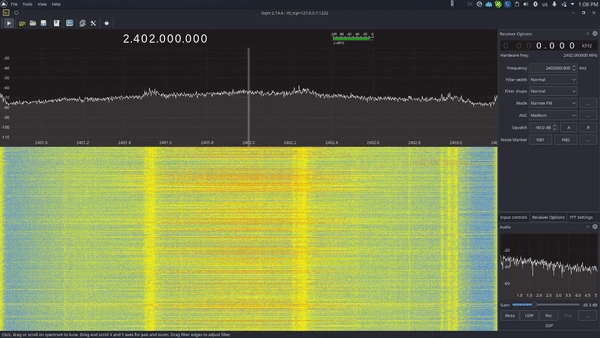es_tcp: Reaching higher frequencies with RTL-SDR
es_tcp is a modification of the well known rtl_tcp utility that can extend the frequency range of the RTL-SDR from 0-6 GHz. This project also takes inspiration (and the files under converter/ files) from this other great project: es_sensor
Tested with GQRX in Debian (sid). Note: You will need to enable the No Limits check box in order to reach higher frequencies than the default 1766 MHz.
Here's how the 2.4 GHz band looks like captured with an RTL-SDR:
Hardware requirements
To be able to reach 6 GHz you will need one of this bad boys otherwise it will work as the regular rtl_tcp.
Installing the udev rules
To install the udev rule and have the downconverter appear as /dev/esenseconv you can do the following:
sudo cp rules/z10-converter.rules /etc/udev/rules.d/
sudo udevadm control --reload
sudo udevadm triggerBuilding
Tested on debian (sid), but it should work for Ubuntu 20.04 and Debian 10. First install the necessary libraries
sudo apt install librtlsdr-dev libusb-1.0-0-dev cmake build-essentialThen build as you would any cmake project:
mkdir build && cd build
cmake ..
make -j$(nproc)Running
./es_tcp -hUsage: [-a Listen address]
[-c Converter path (default: /dev/ttyACM0)
[-p Listen port (default: 1234)]
[-f Frequency to tune to [Hz]]
[-g Gain (default: 0 for auto)]
[-s Sample rate in Hz (default: 2048000 Hz)]
[-b Number of buffers (default: 15, set by library)]
[-n Max number of linked list buffers to keep (default: 500)]
[-d Device index (default: 0)]
[-P PPM error (default: 0)]
[-T Enable bias-T on GPIO PIN 0 (works for rtl-sdr.com v3 dongles)]Example: Listen on port 1222 and the converter path is /dev/esenseconv
./es_tcp -p 1222 -c /dev/esenseconv